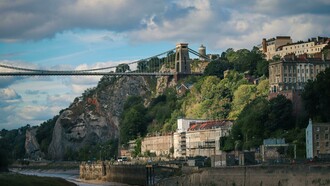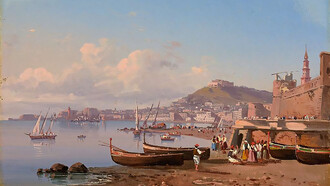The entire environment of which we are a part, including us, has a singularity that makes it unique, diverse, and different. This uniqueness has the potential of alternativity, where our creative capacity can build different paths toward a better future.
(Jose Gabriel Carrasco Ramirez)
I recognize that one of the motivations I have for traveling is to find meaning in life in each place I have visited.
A few years ago I traveled to Costa Rica, curious to know how the natural environment could impact the stability and progress of that nation, to such an extent that it has come to be known as the "Switzerland of America”, although the cordiality of its people far exceeds the profile of that pleasant European country. In my itinerary along the coast of the Caribbean Sea, I placed the Cahuita National Park as a mandatory point of the visit. The path that I walked is an unforgettable experience that I will never stop recommending, including the surprise of finding an old oil exploratory well from the beginning of the 20th century, as well as the wooden walkway on the route to Punta Vargas, being necessary to mention the golden sands beaches that are part of this natural space, which show off their Caribbean quality.
Balance
"The contrast". I heard a lady say that she was following a conversation she was having with some locals, asking what nature was causing in her way of seeing life.
Contrast is the point where opposites are integrated and is the key to the balance of the whole, creating a balance that facilitates a peaceful life.
Martha, I remember she told me her name, had an accent denoting her foreign origin.
"She's German.", I thought.
“I am from Austria.”, she commented like responding to my thought.
When we think of contrast, we usually imagine two different elements placed together and notice the differences between them. Yet the contrast is like the point where evening and dusk, or night and dawn, meet. If we understand the contrast as the integration of different conditions, we can internalize that it is precisely the contrast that makes them complementary and unique.
The lady sensed that my tour of Costa Rica was in mode, as it going out, we will seeing, so she recommended visiting Barra de Parismina to understand what she was saying.
Then, I organized a three-day plan to go to that place inaccessible by land.
Leaving Siquirres, I made a curious journey through banana plantations until I reached the Caño Blanco pier, where I had the opportunity to take the boat-taxi service that, on a tour by the Tortuguero river, lasted about 20 minutes until reaching Parismina.
With a population of 600 people, Parismina has that typical coastal air of Caribbean culture. In addition to the Spanish language, its inhabitants speak a dialect called limonense creole, a mixture of Caribbean English with influences from Spanish and other African and European languages that have evolved for hundreds of years on the Caribbean coast of Costa Rica, especially in the province of Limón, being spoken by the majority of the population in the region. Also, I noticed that some people in Parismina also spoke indigenous languages like Bribri, and Cabécar, which are native languages of Costa Rica.
Pure life
After accommodating my reduced luggage for this trip in pleasant lodging, I went for a walk along the beach of Parismina: a wide strip of black sands!
Of course, I was surprised to discover this peculiarity compared to the Caribbean constant of white or golden sand beaches.
Parismina beach has that dark hue because of the presence of a high amount of volcanic minerals in the sand. Carried by rivers and streams that flow into the sea, this material has been deposited on the beach for centuries.
The presence of these minerals does not affect the quality of the water or make the beach less attractive, on the contrary, it gives it a unique and distinctive look that makes it special. Adding the bohemian and ecological touch, Parismina acquires the status of a magical place.
According to local history, the name "Parismina" comes from the combination of two indigenous words that were used to describe the place.
The first word is "paris", which in the Cabécar language means "river" or "water". The second word is "mine", which in the Bribri language refers to an area surrounded by mountains.
In the local indigenous culture, this place was considered sacred and was believed to have healing and magical powers. The ancient inhabitants of the area came there in search of refuge and healing. As settlers arrived in the region, the name Parismina was adopted to describe the area and eventually became the official name for the community.
This ancestral belief is a reflection of the deep connection that exists between indigenous cultures and nature, and how the perception of the sacred has an integrating effect.
After this first walk, I signed up for a vigil program with an ecological group dedicated to the conservation of sea turtles, which would walk the Parismina beach at dawn to observe how these extraordinary creatures came to lay their eggs. Being the end of April, the full moon favored the arrival of the turtles. That night we saw a Leatherback Turtle over 2 meters arrive. In about three hours which seemed very long to me, this turtle laid more than 100 eggs before returning to the sea.
After waiting another two hours, the volunteers proceeded to dig up the eggs for careful transport to the conservation hatchery, a protected area where the eggs are safe from natural predators and extreme fluctuations in temperature. There the eggs were marked and registered, waiting for about eighty days for the birth of the little turtles.
I confess that that day I began to be a non-militant volunteer ecologist.
Talking with the coordinator of the conservation organization that carried out this commendable work, taking into account that the leatherback turtle is an endangered species, I also asked him about how nature influences the Costa Rican's vision of life.
“The simple life. Pura Vida", told me.
Instead of having a single dominant landscape type, Costa Rica has a wide variety of ecosystems that coexist and complement each other. In addition, each of these natural environments has its own biodiversity, which has adapted to the specific conditions of each habitat. And we, who are part of that ecosystem, have also managed to assimilate the need to interact while maintaining balance, always using the simplest way. A complex attitude distorts our relationship with what surrounds us, moving us away from true freedom. “Have you not been to Playa Ballena?”, the young man asked me. “Here we are a few who manifest in our environmental feat, how we live freedom. The Parismina way. But in Playa Ballena, you will be able to observe young boys who reflect the spirit of freedom inspired by that particular place.”.
Diversity
Added to the list of my route through Costa Rica, Playa Ballena, located to the south, on the coast of the Pacific Ocean, is a beach surrounded by an impressive natural environment, with an exuberant tropical jungle that gives an intense green to the landscape of the mountains that can be seen from the coast.
The beach is known for its unique whale-shaped form, which can be seen from the air. It is also a popular place to watch humpback whales, during their annual migration periods.
Every year, since May, surfing becomes the axis that mobilizes activity in the area. The Ballena Cup and the Costa Rican National Surf Circuit attract local and international surfers and are an opportunity to show off their skills in the challenging waves of their beaches.
Improvising to add more places to visit on my journey, I decided to stay in a boutique lodge at Dominical, a town near the beach of the same name. I remember that the night I arrived an intense tropical storm broke out, with shocking electrical discharges. And the next day, when I went for a walk on the beach, even with somewhat turbulent weather, I could see dozens of young people who came to the beach to go surfing, taking advantage of the powerful waves that were still present. They all showed that unworried and free air that I think my friend from Parismina was referring to.
I am not familiar with surfing, but around this sport there is a whole cultural context that gives it that unique character, influencing both its practitioners and their families. Many say that it is even a lifestyle.
That afternoon I went to visit Playa Ballena. With fine white sands, its surroundings contrasted with the modest and relaxed experience I had in Parismina. The hotels and resorts in the area reflected the impetus that tourism impregnates in many places in Costa Rica, concentrating the interest of foreign travelers. With a thriving economic activity, the movement around leisure activities and water sports, complement an intricate offer of tours through outstanding natural attractions in the area. Despite the development of the place, the contingent of young people who were on the beach denoted the same air of freedom that I had noticed in the volunteers I met in Parismina.
Talking with Sonia, the manager of the lodge where I had stayed, obviously I had to ask her about the quality of a peaceful nation that characterized Costa Ricans, especially taking into account the complicated reality, not only of other Central American countries but also thinking about South America, particularly due to the social difficulties that Venezuela was going through.
"Diversity.", he claimed.
Costa Rican culture is unique in its diversity, in which different ethnic groups, languages, traditions, and customs converge. It is precisely this diversity that creates a unique culture rich in nuances, in which contrast is one of its main strengths. Our nation learned to respectfully integrate that diversity, and that respect became a trait of our people.
And she went on to say, “Our Nobel Peace Prize winner, former President Oscar Arias expressed that diversity is not a threat to peace, but a source of wealth.”.
“This is something I have to write about”, I told myself.
However, I must confess that the lines that I am sharing here are a small glimpse of my entire journey through this beautiful country.
From its unique character, I was left with a reflection. There is no way of comparison with Switzerland. Definitely, it is the Costa Rica of America.
And from Oscar Arías' speech upon receiving the Nobel Peace Prize in 1987, I firmly believe that "Peace is not the absence of conflicts, but the ability to resolve them without resorting to violence (...) It is not about asking for the impossible, but about building the possible.".















